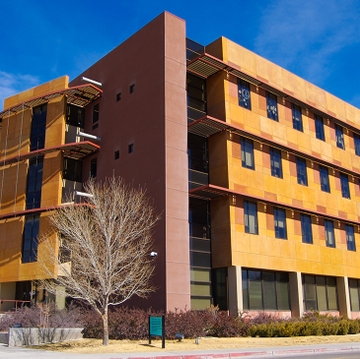UNMCCC earns transportation grants from ACS

Creating a Vaccine against COVID-19
UNM scientists apply their virus-like particles, which use interchangeable parts, to combat the virus that causes COVID-19
David Peabody, PhD, and Bryce Chackerian, PhD, are creating vaccines from particles that are the opposite of Trojan Horses: they look deadly on the outside but are harmless on the inside.
The idea, says Peabody, is to trick the body into believing it's been infected with a microscopic foe. The body's reaction to the supposed infection prepares it for an assault by the real foe.
Scientists at The University of New Mexico, Peabody and Chackerian are using a one-year $250,000 grant to make a vaccine to protect against COVID-19 using the virus-like particles that they developed.
The spherical particles are produced by bacteria and can be made to look like anything dangerous: a parasite, a cancer cell, a virus. Peabody can genetically engineer the particles to display a part of the parasite's, cell's or virus' surface proteins - the part is called an epitope - on the outside. The repeating epitope pattern incites the immune system to react strongly and form antibodies against the epitope.
Decorating the outside of virus-like particles with epitopes isn't enough to ward off disease, though. Antibodies are as uniquely shaped as the epitopes to which they bind. Chackerian explains that not all antibodies will stop a virus.
"For viral vaccines, the goal is to produce neutralizing antibodies," he says. "This is an antibody that can attach to the virus and then effectively prevent the virus from infecting a cell."
To make a vaccine against COVID-19, Chackerian and Peabody are using knowledge of the genome of the SARS-CoV-2 virus, which causes the respiratory disease.
Peabody summarizes, "We make a virus-like particle that displays on its surface bits of SARS-CoV-2. And if those bits of SARS-CoV-2 elicit antibodies that neutralize the virus, that's a vaccine."
Peabody and Chackerian say they can make vaccine candidates quickly and they have a system that can direct the immune system to respond to specific epitopes. Previously, their virus-like particles have been used to make vaccines to target human papillomavirus, malaria, and even metastatic breast cancer cells.
"The goal," says Chackerian, "would be to develop a vaccine that would develop strong and long-lasting responses to the parts of the virus that are critical for its function."
Peabody and Chackerian don't know the specific parts of the SARS-CoV-2 virus to target, but they can make educated guesses. In addition to the genome sequence of the SARS-CoV-2 virus, they have information about how people's immune systems responded to a similar virus during the SARS outbreak in 2003. Peabody says that the two viruses are structurally similar enough that they likely share critical epitopes.
But each vaccine candidate will need to be tested for its ability to elicit antibodies that block virus entry into a cell. Testing requires time and a scientific team. Peabody and Chackerian's team includes Steven Bradfute, PhD, at the UNM Center for Global Health, and Kathryn Frietze, PhD, and Alison Kell, PhD, at UNM's Department of Molecular Genetics and Microbiology.
To make a pipeline of possible vaccines, Peabody and Frietze select potential epitope targets and engineer the virus-like particles. Chackerian vaccinates test animals and collects blood samples from them. He and Kell are also conducting studies to confirm that the vaccines actually bind to their intended cellular targets. And, Bradfute is testing blood samples from the animals to verify that their antibodies block infection.
This work and these tests take place before clinical trials. Once a vaccine candidate is successful in a clinical trial, though, Peabody and Chackerian plan to work with a partner and expect to produce large amounts of vaccine in a short time.
Clinical trials, however, can take years to ensure safety and efficacy. But Peabody and Chackerian see another advantage the virus-like particles can offer.
"We imagine a world in which there's a platform technology that's pre-approved for use [in humans], with interchangeable parts that you trade out to correspond to whatever threat you're trying to address," says Peabody. "[So] that adding another epitope from a different agent will be approved more quickly than if you have to start entirely from scratch."
David Peabody, PhD, is a Professor in the Department Molecular Genetics and Microbiology at the UNM School of Medicine and a member-at-large of the UNM Comprehensive Cancer Center.
Bryce Chackerian, PhD, is a Professor and the Vice Chair of the Department of Molecular Genetics and Microbiology at the UNM School of Medicine and a full member of the UNM Comprehensive Cancer Center.
The National Cancer Institute of the National Institutes of Health is supporting the research reported in this publication under Award Number P30CA118100-15S5. Principal Investigator: David Peabody, PhD. The content is solely the responsibility of the authors and does not necessarily represent the official views of the National Institutes of Health.
UNM Comprehensive Cancer Center
The University of New Mexico Comprehensive Cancer Center is the Official Cancer Center of New Mexico and the only National Cancer Institute-designated Cancer Center in a 500-mile radius.
Its more than 120 board-certified oncology specialty physicians include cancer surgeons in every specialty (abdominal, thoracic, bone and soft tissue, neurosurgery, genitourinary, gynecology, and head and neck cancers), adult and pediatric hematologists/medical oncologists, gynecologic oncologists, and radiation oncologists. They, along with more than 600 other cancer healthcare professionals (nurses, pharmacists, nutritionists, navigators, psychologists and social workers), provide treatment to 65% of New Mexico's cancer patients from all across the state and partner with community health systems statewide to provide cancer care closer to home. They treated approximately 14,000 patients in about 100,000 ambulatory clinic visits in addition to in-patient hospitalizations at UNM Hospital.
A total of nearly 400 patients participated in cancer clinical trials testing new cancer treatments that include tests of novel cancer prevention strategies and cancer genome sequencing.
The more than 100 cancer research scientists affiliated with the UNMCCC were awarded $35.7 million in federal and private grants and contracts for cancer research projects. Since 2015, they have published nearly 1000 manuscripts, and promoting economic development, they filed 136 new patents and launched 10 new biotechnology start-up companies.
Finally, the physicians, scientists and staff have provided education and training experiences to more than 500 high school, undergraduate, graduate, and postdoctoral fellowship students in cancer research and cancer health care delivery.

